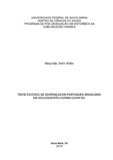| dc.creator | Muller, Maryndia Diehl | |
| dc.date.accessioned | 2021-10-08T18:44:37Z | |
| dc.date.available | 2021-10-08T18:44:37Z | |
| dc.date.issued | 2019-07-18 | |
| dc.identifier.uri | http://repositorio.ufsm.br/handle/1/22375 | |
| dc.description.abstract | This study aimed to investigate the applicability and performance of normal
hearing adolescents with the new Dichotic Sentence Identification Test in Brazilian
Portuguese in the free and directed attention stages, according to gender and ear
side variables. The sample was composed of 28 subjects, 20 women and 8 men,
aged between 12 and 17 years of age, with mean age of 15:8 years. A audiological
basic assessment and the Dichotic Digits Test were established as inclusion criteria.
To evaluate the dichotic listening was used for Brazilian Portuguese Dichotic
Sentence Identification Test of 50 dB NS, investigating the performance the free and
directed attention stages. The adolescents were able to understand and perform the
tasks proposed by the Dichotic Sentence Identification Test in Brazilian Portuguese.
There was no statistically significant difference regarding gender. In the free attention
stage, the average performance of the right was 93.93% and the left 84.64%. It was
considered as a cutoff point for the right ear 90% of correct answers and for the left
ear 80%, with a statistically significant difference between the ears. The asymmetry
between the ears considered expected for this population was up to 10%, with the
advantage of the right ear. In the directed attention stage, the average performance
was approximately 99%, and the expected value in this task was 100%, in both ears,
for this population. It was verified the applicability of the new proposed test in the
evaluated population. Data showed asymmetry according to the ear side in the free
attention stage, with the advantage of the right ear. | eng |
| dc.language | por | por |
| dc.publisher | Universidade Federal de Santa Maria | por |
| dc.rights | Attribution-NonCommercial-NoDerivatives 4.0 International | * |
| dc.rights.uri | http://creativecommons.org/licenses/by-nc-nd/4.0/ | * |
| dc.subject | Testes auditivos | por |
| dc.subject | Audição | por |
| dc.subject | Percepção auditiva | por |
| dc.subject | Hearing tests | eng |
| dc.subject | Hearing | eng |
| dc.subject | Auditory | eng |
| dc.subject | Perception | eng |
| dc.title | Teste dicótico de sentenças em português brasileiro em adolescentes normo-ouvinte | por |
| dc.title.alternative | Brazilian portuguese dichotic sentence identification test in normal hearing adolescents | eng |
| dc.type | Dissertação | por |
| dc.description.resumo | Esta pesquisa teve como objetivo investigar a aplicabilidade e desempenho
de adolescentes normo-ouvintes com o novo Teste Dicótico de Sentenças em
Português Brasileiro nas etapas de atenção livre e direcionada, segundo as variáveis
sexo e lado da orelha. Constituíram a amostra 28 sujeitos, 20 do sexo feminino e 8
do sexo masculino, com idade entre 12 e 17 anos, com média de idade de 15:8
anos. A avaliação audiológica básica e o Teste Dicótico de Dígitos foram aplicados
como critérios de inclusão. Para avaliar a habilidade de escuta dicótica foi utilizado o
teste Dicótico de Sentenças em Português Brasileiro, no nível de apresentação de
50 dB NS, investigando o desempenho nas etapas de atenção livre e direcionada.
Os adolescentes foram capazes de compreender e executar as tarefas propostas
pelo Teste Dicótico de Sentenças em Português Brasileiro. Não houve diferença
estatisticamente significante em relação ao sexo. Na etapa de atenção livre, o
desempenho médio da orelha direita foi de 93,93% e da orelha esquerda de 84,64%.
Foi considerado como ponto de corte para o orelha direita 90% de acertos e para a
orelha esquerda 80 %, com diferença estatisticamente significante entre as orelhas.
A assimetria entre as orelhas considerada esperada para esta população foi de até
10 %, com vantagem da orelha direita. Na etapa de atenção direcionada, o
desempenho médio foi de aproximadamente 99%, sendo que o valor esperado nesta
tarefa foi de 100%, em ambas as orelhas, para esta população. Constatou-se a
aplicabilidade do novo teste proposto na população avaliada. Os dados
evidenciaram assimetria segundo o lado da orelha na etapa de atenção livre, com
vantagem da orelha direita. | por |
| dc.contributor.advisor1 | Costa, Maristela Julio | |
| dc.contributor.advisor1Lattes | http://lattes.cnpq.br/5004340831068086 | por |
| dc.contributor.referee1 | Garcia, Michele Vargas | |
| dc.contributor.referee2 | Balen, Sheila Andreoli | |
| dc.contributor.referee3 | Biaggio, Eliara Pinto Vieira | |
| dc.creator.Lattes | http://lattes.cnpq.br/7022044275398746 | por |
| dc.publisher.country | Brasil | por |
| dc.publisher.department | Fonoaudiologia | por |
| dc.publisher.initials | UFSM | por |
| dc.publisher.program | Programa de Pós-Graduação em Distúrbios da Comunicação Humana | por |
| dc.subject.cnpq | CNPQ::CIENCIAS DA SAUDE::FONOAUDIOLOGIA | por |
| dc.publisher.unidade | Centro de Ciências da Saúde | por |



